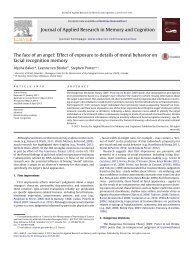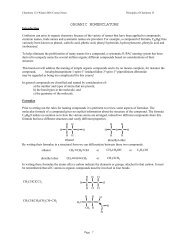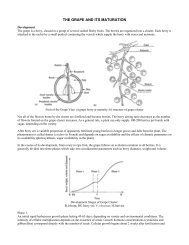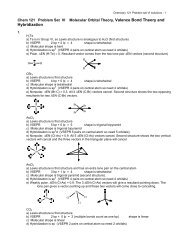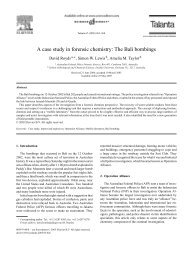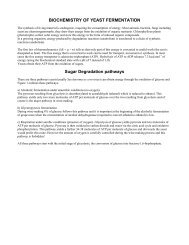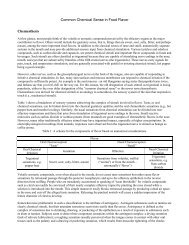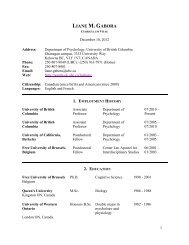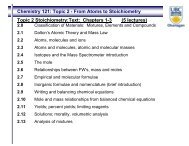Discovering Deceit.pdf - University of British Columbia
Discovering Deceit.pdf - University of British Columbia
Discovering Deceit.pdf - University of British Columbia
Create successful ePaper yourself
Turn your PDF publications into a flip-book with our unique Google optimized e-Paper software.
Chapter 9<br />
<strong>Discovering</strong> <strong>Deceit</strong>: Applying Laboratory<br />
and Field Research in the Search for Truthful<br />
and Deceptive Behavior<br />
Leanne ten Brinke and Stephen Porter<br />
Introduction<br />
“Science is the captain, and practice the soldiers”—Leonardo da Vinci<br />
da Vinci’s sage observation may be conceptualized as a guide for applied<br />
researchers; the most meaningful psychological research addresses an interesting<br />
topic with both basic and applied relevance. Once identi fi ed, the phenomenon<br />
<strong>of</strong> interest should be studied both in the lab—<strong>of</strong>fering a high level <strong>of</strong> internal<br />
validity—and in the “ fi eld”, lacking experimental control but <strong>of</strong>fering more realism,<br />
and not rushing to scienti fi c judgment based on or the other (Yuille, 1996 , present<br />
volume). Subsequently, converging empirical fi ndings from the lab and fi eld should<br />
be responsibly applied in the legal context (e.g., Paz-Alonso, Ogle, & Goodman,<br />
present volume; Yuille, 1989 ) . One program <strong>of</strong> research exemplifying these principles<br />
is outlined in this chapter: detecting deception.<br />
A key role <strong>of</strong> judges and jurors at trial is to decide whether various witnesses are<br />
lying or telling the truth (see Seniuk, present volume). But is it possible to determine<br />
accurately whether a witness is providing an honest and accurate version <strong>of</strong> events, an<br />
unintentionally mistaken memory, or lying through his/her teeth? This issue is not trivial;<br />
in an adversarial system, most trials feature contradictory testimony by witnesses<br />
(see Connolly & Price, present volume; also see Fisher, Vrij, & Leins, present volume,<br />
for research focusing on contradictory statements within witnesses). In increasingly<br />
common “he said, she said” cases, there is little or no evidence other than con fl icting<br />
stories told by a complainant and defendant, and decision-making is guided almost<br />
entirely by credibility assessments (e.g., Porter, Campbell, Birt & Woodworth, 2003 ) .<br />
For example, the judge in the Air India mass murder case ( R. v. Malik & Bagri , 2005 )<br />
concluded that the case was reduced to a credibility contest: “… the determination <strong>of</strong><br />
L. ten Brinke (*) • S. Porter<br />
Haas School <strong>of</strong> Business , UC Berkeley, Berkeley , CA , USA<br />
<strong>University</strong> <strong>of</strong> <strong>British</strong> <strong>Columbia</strong> , Kelowna , BC , Canada<br />
e-mail: leannetenbrinke@berkeley.edu<br />
B.S. Cooper et al. (eds.), Applied Issues in Investigative Interviewing,<br />
Eyewitness Memory, and Credibility Assessment, DOI 10.1007/978-1-4614-5547-9_9,<br />
© Springer Science+Business Media New York 2013<br />
221
222 L. ten Brinke and S. Porter<br />
guilt devolves to the weighing <strong>of</strong> the credibility <strong>of</strong> a number <strong>of</strong> witnesses who testi fi ed<br />
in these proceedings (para. 5).” In fact, we would argue that credibility assessment is the<br />
“bread and butter” task for judges and juries in all trials. Our research team has been<br />
interested in both the behaviors that are actually associated with deception, and the<br />
manner in which others (such as judges) assess credibility.<br />
Deception is an important and common aspect <strong>of</strong> human social interaction present<br />
in much <strong>of</strong> interpersonal interaction. People confess to using deceit in 14% <strong>of</strong> emails,<br />
27% <strong>of</strong> face-to-face interactions, and 37% <strong>of</strong> phone calls (Hancock, 2007 ; Hancock<br />
& Woodworth, present volume), and lie on average about twice a day (DePaulo,<br />
Kashy, Kirkendol, Wyer, & Epstein, 1996 ) . Although most everyday lies do not carry<br />
heavy consequences, deception in the interview room, courtroom, or parole hearing<br />
holds enormous consequences at both the individual and societal level. Despite the<br />
widespread use <strong>of</strong> deception, it is notoriously dif fi cult to detect; when asked to determine<br />
whether another person is lying, most people, including police <strong>of</strong> fi cers and<br />
judges perform at or only slightly better than chance (e.g., Bond & DePaulo, 2006 ;<br />
Ekman & O’Sullivan, 1991 ) . Despite empirical fi ndings that deception detection is a<br />
dif fi cult task laden with errors, people are typically con fi dent in their ability to spot<br />
a liar and consider it to be a simple assessment (e.g., Vrij, 2000 ) .<br />
Demonstrating the dif fi culty <strong>of</strong> this task and the major misconceptions concerning<br />
deceptive behavior, Porter, Woodworth, and Birt ( 2000 ) found that Canadian<br />
federal parole <strong>of</strong> fi cers performed signi fi cantly below chance at detecting deception<br />
in videotaped speakers. Such a low rate <strong>of</strong> accuracy strongly suggests that these<br />
pr<strong>of</strong>essionals were actively attending to misleading cues and making mistakes.<br />
Fortunately, empirically based training methods that provide pr<strong>of</strong>essionals with<br />
reliable verbal and nonverbal cues to deception, gathered from decades <strong>of</strong> research<br />
on deceptive behavior (for a meta-analytic review, see DePaulo et al., 2003 ) , have<br />
been shown to be at least modestly successful (see Colwell, Hiscock-Anisman, &<br />
Fede, present volume). The same federal parole <strong>of</strong> fi cers who detected deception<br />
below chance increased their accuracy to 76.7% after a 2-day training program<br />
(Porter et al., 2000 ) . With advances in knowledge <strong>of</strong> deception through laboratory<br />
and fi eld studies, there is a reason to believe that empirically validated training<br />
could achieve even greater success in the near future.<br />
Deception Detection by Police<br />
The consequences <strong>of</strong> the failed identi fi cation <strong>of</strong> concealed and falsi fi ed information<br />
are enormous in many contexts, including suspect interviews, customs agencies,<br />
airport security, and the courtroom (e.g., Porter & ten Brinke, 2008 ) . For example,<br />
the failure to detect deception by a suspect who denies his or her involvement in a<br />
crime might allow a proli fi c <strong>of</strong>fender to return to society and continue to victimize<br />
innocent people. Alternatively, an innocent suspect who is thought to be lying might<br />
be wrongfully convicted (see Yarbrough, Hervé, & Harms, present volume). In their<br />
daily interactions with citizens, police <strong>of</strong> fi cers’ ability to detect deception serves as
9 <strong>Discovering</strong> <strong>Deceit</strong><br />
223<br />
a “front line” defence in the prevention <strong>of</strong> false allegations and the prosecution <strong>of</strong><br />
guilty parties. Given that many police <strong>of</strong> fi cers receive some form <strong>of</strong> deception<br />
detection training (most commonly in the Reid technique; Inbau, Reid, Buckley, &<br />
Jayne, 2001 ) and encounter potentially deceptive individuals on a daily basis, one<br />
might expect that they would be especially skilled in this task. However, research<br />
suggests that police <strong>of</strong> fi cers perform no better than lay persons in deception detection<br />
tasks; like the average person, police tend to “ fl ip a coin” when making assessments<br />
<strong>of</strong> credibility (e.g., Bond & DePaulo, 2006 ; Ekman & O’Sullivan, 1991 ;<br />
Garrido, Masip, & Herrero, 2004 ) .<br />
Although many deception detection tasks employed in research thus far appear<br />
“arti fi cial” (e.g., use <strong>of</strong> university student participants, low motivation lies; see<br />
O’Sullivan, present volume) for police <strong>of</strong> fi cers, similar levels <strong>of</strong> accuracy have been<br />
replicated in more ecologically valid tasks (Vrij & Mann, 2001 ) . In missing persons<br />
cases, relatives are <strong>of</strong>ten considered persons <strong>of</strong> interest despite their attempts to<br />
assist police and aid in the search for their lost relative. Real-life, high-stakes lies<br />
occur when those that make emotional pleas to the public for information about<br />
their missing loved ones are later uncovered as the murderer themselves (e.g., Michael<br />
White <strong>of</strong> Alberta, Canada, who claimed his pregnant wife went missing after he<br />
brutally murdered her and dumped her body in the woods). Vrij and Mann ( 2001 )<br />
had police <strong>of</strong> fi cers view such footage and asked them to assess the sincerity <strong>of</strong> the<br />
emotional pleas. Similar to laboratory-based studies, these fi ndings suggested that<br />
police <strong>of</strong> fi cers were unable to detect deceit in this context above the level <strong>of</strong> chance<br />
and, while those with interviewing experience were more con fi dent in their judgments,<br />
they were no more accurate than less experienced <strong>of</strong> fi cers. However, police<br />
<strong>of</strong> fi cers may be better at detecting deceit in an investigative interview. Mann, Vrij,<br />
and Bull ( 2004a ) asked police <strong>of</strong> fi cers to classify the veracity <strong>of</strong> videotaped segments<br />
<strong>of</strong> real-life suspect interviews, and found accuracy to be around 65%,<br />
signi fi cantly greater than chance. As such, some laboratory-based assessments <strong>of</strong><br />
deception detection skill may underestimate real-world accuracy. Despite this possible<br />
underestimation <strong>of</strong> their accuracy, there remains a high level <strong>of</strong> error and a<br />
need for more accurate assessments.<br />
Perhaps as a consequence <strong>of</strong> their line <strong>of</strong> work, police <strong>of</strong> fi cers tend to show a<br />
deception bias—labelling more (i.e., guilty and innocent) individuals as liars than<br />
what would be expected by chance or in comparison with a layperson (Garrido,<br />
Masip, & Herrero, 2004 ) . Meissner and Kassin ( 2002 ) found that training and prior<br />
experience increased the likelihood <strong>of</strong> believing a speaker was being deceitful.<br />
Further, training and prior experience can in fl ate con fi dence in one’s ability to detect<br />
deceit (DePaulo & Pfeifer, 1986 ) . For example, experimental training for a group <strong>of</strong><br />
student participants in the popular (but largely unvalidated) Reid technique (Inbau<br />
et al., 2001 ) actually resulted in poorer performances in detecting deceit than their<br />
untrained counterparts (Kassin & Fong, 1999 ) . Despite the decrease in performance,<br />
trained students were signi fi cantly more con fi dent in their assessments, signalling<br />
trouble for <strong>of</strong> fi cers trained in this manner.<br />
Training in the Reid technique, in particular, may impair the ability to detect deception,<br />
given that it does not endorse appropriate attention to empirically substantiated
224 L. ten Brinke and S. Porter<br />
cues (in fact, quite the opposite; see Walsh & Bull, present volume). Vrij, Mann, and<br />
Fisher (2006 ) conducted the fi rst empirical test <strong>of</strong> the Reid recommendations for<br />
detecting deceit in a behavior analysis interview (BAI), as described by Inbau et al.<br />
(2001 ) . While Reid and colleagues suggest that lies will be accompanied by nervous<br />
behaviors associated with discomfort, they fail to account for the importance <strong>of</strong><br />
impression management. In Vrij et al.’s (2001) study, deceptive participants exhibited<br />
behaviors opposite <strong>of</strong> those predicted by the BAI, while genuine participants appeared<br />
nervous and uncomfortable, providing an explanation for the decrease in accuracy<br />
reported by Kassin and Fong ( 1999 ) . Thus, the convergence <strong>of</strong> evidence from laboratory<br />
and applied studies suggests that attempts to enhance deception detection skills<br />
with empirically valid practices among police <strong>of</strong> fi cers would be a worthwhile endeavour<br />
(see Griesel, Ternes, Schraml, Cooper, & Yuille, present volume).<br />
Deception Detection in the Courtroom<br />
After the initial investigation and credibility determination by police, a subsequent<br />
step on the proverbial path to justice occurs in the courtroom where the determination<br />
<strong>of</strong> an individual’s credibility is <strong>of</strong> utmost importance to rulings <strong>of</strong> guilt and<br />
innocence. How does a judge or juror decide whether a witness is providing an honest<br />
and accurate recollection <strong>of</strong> events, an unintentionally mistaken memory, or<br />
intentionally providing a false account? As indicated above, this issue is not trivial;<br />
in an adversarial legal system such as Canada’s, most trials feature contradictory<br />
testimony. In many cases, con fl icting testimony by witnesses represents the only<br />
evidence available, and determinations <strong>of</strong> guilt or innocence are guided almost<br />
entirely by credibility assessment. Thus, we suggest that the determination <strong>of</strong> an<br />
individual’s credibility is a fundamental task for judges and juries with weighty<br />
consequences (see Seniuk, present volume). The assessment <strong>of</strong> credibility is made<br />
more dif fi cult when historical <strong>of</strong>fenses are brought to trial, particularly in countries<br />
such as Canada with no statute <strong>of</strong> limitations.<br />
Given the central role <strong>of</strong> credibility assessment in judicial decision-making, it is<br />
important to examine the manner in which it is viewed and approached by the court.<br />
A review <strong>of</strong> rulings on the matter clearly points to the predominant view that credibility<br />
assessment is a straightforward matter, best undertaken with the use <strong>of</strong> “common<br />
sense.” In R. v. Marquard ( 1993 ) , the Canadian Supreme Court concluded that<br />
the determination <strong>of</strong> the honesty is common sense : “Credibility is a matter within<br />
the competence <strong>of</strong> lay people. Ordinary people draw conclusions about whether<br />
someone is lying or telling the truth on a daily basis” (p. 248). Similarly, in R. v.<br />
Francois ( 1994 ) , Justice McLachlin stated: “In the end, the jury must decide whether<br />
it believes the witness’ story in whole or in part. That determination turns … on the<br />
demeanour <strong>of</strong> the witness and the common sense <strong>of</strong> the jury” (see Seniuk, present<br />
volume, for a discussion <strong>of</strong> demeanour evidence).<br />
This common sense argument advocated by Canada’s highest court is incompatible<br />
with the empirically-based conclusion that credibility assessment is a highly
9 <strong>Discovering</strong> <strong>Deceit</strong><br />
225<br />
complex and <strong>of</strong>ten unreliable task (e.g., Bond & DePaulo, 2006 ; Vrij, 2000 ) . At a<br />
2005 judicial education conference in which the second author gave a workshop on<br />
credibility assessment, 16 Canadian judges completed questionnaires (e.g., at baseline)<br />
regarding their beliefs about verbal, vocal, and nonverbal behaviors as they<br />
might relate to deception (Porter & ten Brinke, 2009 ) . For all questions, the judges’<br />
responses about directional differences in valid cues were highly variable (e.g., <strong>of</strong>ten<br />
evenly or near evenly split among possible responses), suggesting a complete lack<br />
<strong>of</strong> consensus about deceptive cues. For example, six judges believed that liars provide<br />
more details that truth-tellers, three judges believed the opposite, two did not<br />
believe there was a difference in level <strong>of</strong> detail, and fi ve did not know if there was a<br />
relationship between amount <strong>of</strong> detail and veracity. Further, the judges expressed a<br />
high level <strong>of</strong> con fi dence in their ability to detect deception (Porter & ten Brinke,<br />
2008 ) . However, judges, as with police <strong>of</strong> fi cers and laypersons, perform around the<br />
level <strong>of</strong> chance in judging the credibility <strong>of</strong> videotaped speakers (Ekman &<br />
O’Sullivan, 1991 ) .<br />
While it is not possible to know the frequency <strong>of</strong> mistakes concerning credibility<br />
in the courtroom, recent wrongful convictions suggest that credibility assessment is<br />
a highly fallible process and by no means a matter <strong>of</strong> mere common sense. Such<br />
cases also highlight the gravity <strong>of</strong> the consequences <strong>of</strong> fl awed credibility assessments.<br />
In a 2001 inquiry into Thomas Sophonow’s wrongful conviction for the murder<br />
<strong>of</strong> Barbara Stoppel, Justice Cory concluded that the testimony <strong>of</strong> “honest,<br />
right-thinking (but inaccurate) witnesses” and “smooth and convincing liars”<br />
contribute to false convictions (e.g., Wilson, 2003 ) .<br />
Cues to Deception<br />
Despite the evidence that judges, police <strong>of</strong> fi cers, and laypersons apply strategies<br />
that disallow effective credibility assessments, effective strategies may exist. Three<br />
primary theories have emerged to predict cues to deception: the content complexity,<br />
attempted control, and emotional approaches (e.g., Porter & Yuille, 1995 ; Vrij,<br />
2000, 2008 ) . Content complexity (Vrij, 2008 ) suggests that lying is more cognitively<br />
dif fi cult than telling the truth and will, therefore, result in measurable differences<br />
such as shorter stories, repetitions to avoid contradictions, and a neglect <strong>of</strong><br />
body language (see Colwell et al., present volume). Alternatively, the attempted<br />
control approach (Vrij, 2008 ) suggests that liars channel considerable effort into<br />
behaving normally. However, it is not possible for liars to consciously replicate all<br />
aspects <strong>of</strong> behavior that occur naturally during truthful discussion, leading to overly<br />
rigid or suspiciously smooth behavior. Finally, the emotional approach (Vrij, 2008 )<br />
predicts that deception is accompanied by guilt, fear, and excitement re fl ected in<br />
patterns <strong>of</strong> nervous behavior. Although no single cue signals deceit (see Yarbrough<br />
et al., present volume), a large body <strong>of</strong> literature has highlighted a variety <strong>of</strong> verbal,<br />
behavioral, and facial cues to deception (see Colwell et al., present volume; Griesel<br />
et al., present volume; O’Sullivan, present volume). In a 2003 meta-analysis <strong>of</strong> 120
226 L. ten Brinke and S. Porter<br />
independent samples, DePaulo et al. ( 2003 ) found support for elements <strong>of</strong> each <strong>of</strong><br />
these theories: liars provided fewer details, spent less time talking, told less plausible<br />
stories, used fewer illustrators, and appeared more nervous than truth tellers.<br />
While this synthesis provided a concise summary <strong>of</strong> relevant cues to deception, it<br />
should be noted that, <strong>of</strong> the 120 samples included, 101 were studies in which students<br />
served as participants in arti fi cial situations. As such, an examination <strong>of</strong><br />
deceptive cues within forensically relevant populations and settings is needed.<br />
There are reasons to believe that criminal <strong>of</strong>fenders may behave differently<br />
when engaging in deception. First, criminals likely have greater practice in (forensically-relevant)<br />
deception than the average individual—maintaining lies about<br />
their criminal involvement for years or decades (e.g., Porter & Woodworth, 2007 ) .<br />
Given this extensive experience with deceit, it is not surprising that criminals report<br />
more realistic beliefs about deceptive behavior and consider the task to require less<br />
effort when compared to students’ responses on the same survey (Granhag,<br />
Andersson, Strömwall, & Hartwig, 2004 ) . Further, criminals are able to capitalize<br />
on their knowledge <strong>of</strong> deception, outperforming students on deception detection<br />
tasks (Hartwig, Granhag, Strömwall, & Andersson, 2004 ) . However, to date, few<br />
studies have examined the deceptive behavior <strong>of</strong> <strong>of</strong>fender samples. An examination<br />
by Porter, Doucette, Earle, and MacNeil ( 2008 ) had <strong>of</strong>fenders and students tell<br />
genuine and deceptive autobiographical stories and compared deceptive behavior<br />
across the samples. As suspected, some differences emerged: <strong>of</strong>fenders engaged in<br />
more self-manipulations and less smiling during deception. It was theorized that<br />
these behavioral differences were attempts on behalf <strong>of</strong> the <strong>of</strong>fenders to appear<br />
credible and distract listeners from their speech content. Vrij and colleagues have<br />
conducted increasingly relevant studies <strong>of</strong> deceptive behavior during real-world<br />
interrogations in which suspects were known to have lied. Results suggest that cues<br />
associated with nervousness do not differentiate between genuine and deceptive<br />
statements in this context; however, suspects engaged in longer pauses and blinked<br />
less frequently when lying (Mann, Vrij, & Bull, 2004b ) . Thus, while research has<br />
highlighted some potentially valuable cues to deception, fi eld studies suggest that<br />
additional research is warranted to understand which <strong>of</strong> those cues are most useful<br />
in applied settings.<br />
A complementary approach to detecting deception is the baseline method, in<br />
which behavioral cues associated with deceit are compared during known truthful<br />
statements and potentially deceptive statements. Given that cognitively controllable<br />
behaviors (e.g., illustrator use) may increase or decrease during deception, according<br />
to individual differences (e.g., experience with deception in criminal contexts;<br />
impression management skills), using each person as their own basis for comparison<br />
may enhance our ability to detect aberrant—potentially deceitful—behavior<br />
(Vrij, 2008 ) . Indeed, in a recent study by the authors, the baseline approach revealed<br />
emotional, verbal, and nonverbal behavior differences in genuine vs. deceptive<br />
accounts <strong>of</strong> remorse (ten Brinke, MacDonald, Porter, & O’Connor, 2012 ) .<br />
The dif fi culty <strong>of</strong> detecting deception and the ability <strong>of</strong> liars, particularly <strong>of</strong>fenders,<br />
to engage in impression management techniques has prompted researchers to<br />
search for less controllable cues to deceit. One such proposed channel is facial
9 <strong>Discovering</strong> <strong>Deceit</strong><br />
227<br />
expressions <strong>of</strong> emotion. Some research has suggested that genuine and deceptive<br />
emotional expressions can be differentiated by the trained observer. While deceivers<br />
can easily mimic the up-turned mouth involved in a smile, it is more dif fi cult to<br />
mimic the muscular activity around the eyes (i.e., produced by the orbicularis oculi )<br />
associated with genuine happiness (Ekman, Davidson, & Friesen, 1990 ) . Darwin<br />
( 1872 ) posited that certain, uncontrollable facial muscles may be responsible for<br />
leakage <strong>of</strong> true emotion during deceptive emotional expressions. Borrowing from<br />
Darwin’s observation is Ekman’s famous proposal that, when an emotion is concealed,<br />
the true emotion may be revealed through a “micro-expression”—a brief but<br />
complete facial expression—which reveal the felt emotion during emotional concealment<br />
and is usually suppressed within 1/5 – 1/25th <strong>of</strong> a second (e.g., Ekman,<br />
1992 ) . Despite the popularity <strong>of</strong> both suggestions, neither supposition had received<br />
direct, empirical examination until a recent study by Porter and ten Brinke (2008).<br />
Participants viewed disgusting, sad, frightening, happy, and neutral images, responding<br />
to each with a genuine or deceptive (i.e., simulated, neutralized, or masked)<br />
expression. Each 1/30th-second frame <strong>of</strong> the expression (i.e., 104,550 frames in 697<br />
expressions) was analyzed for the presence <strong>of</strong> universal emotional expressions<br />
(i.e., micro-expressions, and longer-lasting emotional expressions that revealed<br />
feelings inconsistent with the intended emotional display). Relative to genuine emotions,<br />
masked emotions contained more inconsistent expressions and a higher blink<br />
rate. Inconsistent expressions were more frequent and longer in falsi fi ed negative<br />
emotions than in happiness expressions. “Ekman micro-expressions” occurred<br />
rarely—in 2% <strong>of</strong> expressions (e.g., including during genuine expressions in which<br />
participants responded to an emotional image with a congruent emotional facial<br />
expression)—and were expressed in the upper or lower face only. However, the<br />
leakage <strong>of</strong> longer lasting inconsistent emotions was dif fi cult for participants to control—such<br />
expressions lasted slightly longer than a second, on average. As might be<br />
expected based on previous deception detection studies, judges <strong>of</strong> the veracity <strong>of</strong><br />
these facial expression performed at or only slightly above the level <strong>of</strong> chance.<br />
Emotional leakage can reveal deception in other laboratory based tasks too; in a<br />
mock crime study, Jo ( 2010 ) found that deceptive participants (i.e., who denied<br />
stealing $100) revealed their guilty knowledge via fearful and asymmetric facial<br />
expressions. In sum, these results suggest that, given the appropriate knowledge<br />
regarding accurate cues to facial deceit, a careful analysis <strong>of</strong> the face might provide<br />
an important avenue for the detection <strong>of</strong> deception.<br />
The utility <strong>of</strong> emotional facial analysis in applied settings requires research.<br />
Addressing this need, the current authors (ten Brinke & Porter, 2011; ten Brinke,<br />
Porter, & Baker, 2012 ) utilized a similar frame-by-frame approach to analyze videos<br />
<strong>of</strong> perhaps one <strong>of</strong> the highest stakes deception scenarios—those in which relatives<br />
(e.g., honest, innocent vs. deceptive killers) publicly plead for the return <strong>of</strong> their loved<br />
ones. Further, verbal, nonverbal, and linguistic cues to deception were examined in<br />
this high-stakes emotional setting. As in any “ fi eld” study, one challenge has been the<br />
establishment <strong>of</strong> ground truth (see Paz-Alonso et al., present volume; Yuille, present<br />
volume). In cases labelled as deceptive, we selected cases in which the individuals<br />
were later convicted <strong>of</strong> the crime based on persuasive physical (e.g., DNA) or other
228 L. ten Brinke and S. Porter<br />
powerful evidence (e.g., being caught on video). In contrast, innocent individuals<br />
were labelled as such if they were either never suspected <strong>of</strong> involvement or cleared <strong>of</strong><br />
any involvement, and another individual was convicted <strong>of</strong> the crime. Analyses reveal<br />
that deceptive pleaders are more likely to show emotional expressions <strong>of</strong> happiness<br />
and surprise, and are less likely to display the signs <strong>of</strong> sadness/distress that pervade<br />
genuine pleas. Deceptive pleaders also provided shorter pleas (i.e., fewer words) and<br />
used more tentative language, avoiding commitment to their lies. Importantly, however,<br />
this work suggests that facial cues to deception may be a useful cue to deceit in<br />
high-stakes applied settings.<br />
Dangerous Decisions: Why People Fail to Detect <strong>Deceit</strong><br />
in Forensic Settings<br />
Despite the presence <strong>of</strong> verbal, behavioral and facial cues, and recent advances in<br />
the scienti fi c understanding <strong>of</strong> deception (see O’Sullivan, present volume), our<br />
attempts to detect deception remain an inaccurate endeavour (e.g., Bond & DePaulo,<br />
2006 ) . Our Dangerous Decisions Theory (DDT; Porter & ten Brinke, 2009 ) <strong>of</strong>fers a<br />
model outlining the psychological processes involved in arriving at an evaluation <strong>of</strong><br />
credibility, from which we can deduce the pitfalls and promises <strong>of</strong> deception detection.<br />
This model suggests that inaccurate assessments <strong>of</strong> credibility are a product <strong>of</strong><br />
reliance on intuition, incorrect cues, and overcon fi dence leading to tunnel vision in<br />
decision-making (see Yarbrough et al., present volume).<br />
According to DDT (Porter & ten Brinke, 2009 ) , interpersonal judgments <strong>of</strong> trustworthiness<br />
occur almost instantaneously upon seeing an individual’s face.<br />
Trustworthiness is an evaluation <strong>of</strong> interpersonal threat based on signs <strong>of</strong> dominance/strength<br />
(i.e., masculinity) and anger on a stranger’s face (Porter, ten Brinke<br />
& Mathesius, 2012 ) . The process <strong>of</strong> judging another person’s trustworthiness is<br />
associated with increased activity in the primitive brain areas, especially the<br />
amygdala, indicating the presence <strong>of</strong> a “threat” in the environment. The expediency<br />
<strong>of</strong> this process was demonstrated by Willis and Todorov ( 2006 ) who had participants<br />
view images <strong>of</strong> strangers’ faces for 100 ms, 500 ms, 1 s, or unlimited time, and<br />
evaluate trustworthiness. While con fi dence in judgment accuracy increased with<br />
time, the judgments themselves remained virtually unchanged from the initial brief<br />
exposure. Judgments made after only 100 ms <strong>of</strong> exposure had the greatest impact<br />
for ratings <strong>of</strong> trustworthiness, indicating their instantaneous and enduring nature.<br />
Applied to legal contexts, we hypothesize that an investigator, judge, or juror makes<br />
a similar intuitive evaluation <strong>of</strong> the general trustworthiness <strong>of</strong> a suspect/defendant,<br />
complainant, or other witness immediately upon seeing his/her face for the fi rst time<br />
and that this initial impression can impair one’s ability to objectively examine the<br />
credibility <strong>of</strong> a witness’s statement.<br />
While these assessments appear to form rapidly, their accuracy remains a key<br />
issue. As Willis and Todorov ( 2006 ) appear to assume, perhaps these automatic<br />
judgments <strong>of</strong> a stranger’s trustworthiness based on his/her face are accurate.
9 <strong>Discovering</strong> <strong>Deceit</strong><br />
229<br />
However, this assumption lacks support, given that the actual trustworthiness <strong>of</strong> the<br />
target faces presented in their study were unknown. For example, there is considerable<br />
variability in trustworthiness ratings assigned to a common face by different<br />
observers, suggesting that at least some assessors are inaccurate (Adolphs, 2002 ) .<br />
But just how unreliable might the process be? If intuitive judgments <strong>of</strong> trustworthiness<br />
have any validity, the discrimination <strong>of</strong> faces <strong>of</strong> untrustworthy, dangerous<br />
individuals from relatively virtuous, trustworthy individuals should be possible.<br />
Research by Porter, England, Juodis, and ten Brinke ( 2008 ) examined the accuracy<br />
<strong>of</strong> such instantaneous assessments <strong>of</strong> trustworthiness. Participants viewed 34 faces,<br />
comprising Nobel Peace Prize recipients/humanitarians and America’s Most Wanted<br />
criminals, and rated the trustworthiness <strong>of</strong> each. Subsequently, they were informed<br />
about the two groups and estimated group membership. Initial judgments <strong>of</strong> untrustworthy<br />
faces were less accurate (i.e., mean accuracy <strong>of</strong> 48.8%) than those <strong>of</strong> trustworthy<br />
faces (i.e., mean accuracy <strong>of</strong> 62.67%), potentially re fl ecting a trustworthy<br />
bias. However, when asked to assess group membership, judgment accuracy was<br />
slightly above chance for both target types. Despite the small amount <strong>of</strong> information<br />
available to participants (i.e., still facial image only), it appears that intuition plays<br />
a small facilitative role in trustworthiness judgments, but that errors are common.<br />
Further research suggests that these evaluations <strong>of</strong> trustworthiness may be impaired<br />
by a reliance on erroneous facial features. Facial features (unjusti fi ably) associated<br />
with perceived honesty include “babyfacedness”, symmetry, and attractiveness<br />
(Bull, 2006 ; Bull & Vine, 2003 ; Zebrowitz, Voinescu, & Collins, 1996 ) . Because<br />
the initial assessment occurs largely outside <strong>of</strong> our conscious awareness, it may<br />
strike the observer as “intuition”.<br />
A reliance on intuitive feelings about the credibility <strong>of</strong> claims in court is a commonly<br />
cited strategy by judges (see R. v. Mervyn , 2003 ; R. v. Roble , 2004 ; R. v. S.<br />
[R.D.], 1997 ) . Judges may determine the extent to which the testimony held a “ring<br />
<strong>of</strong> truth” by relying on their intuition or “gut instinct” (see Seniuk, present volume)<br />
In R. v. Lifchus ( 1997 ) , Justice Cory noted: “it may be that the juror is unable to<br />
point to the precise aspect <strong>of</strong> the witness’s demeanour which was found to be suspicious<br />
… A juror should not be made to feel that the overall, perhaps intangible,<br />
effect <strong>of</strong> a witness’s demeanour cannot be taken into consideration in the assessment<br />
<strong>of</strong> credibility”. Such intuitive assessments appear to be actively encouraged in<br />
the courtroom. However, there is no evidence that the use <strong>of</strong> intuition is a valid tool<br />
for evaluating credibility. In fact, contrary to Justice Cory’s suggestion, Porter et al.<br />
( 2000 ) found that a self-reported reliance on intuition was related to lower accuracy<br />
in detecting deception. Thus, intuitive judgments <strong>of</strong> the defendant, complainant, or<br />
witness’s face may play a role in an investigator, judge, or jury’s initial assessment<br />
<strong>of</strong> credibility, determining guilt or innocence before due process begins.<br />
The DDT suggests that this rapid process <strong>of</strong> trustworthiness assessment was initially<br />
intended to assess the “danger” to the observer in the evolutionary past (Porter<br />
& ten Brinke, 2009 ; Todorov, 2008 ). However, in the modern legal context, the<br />
impression leads to biased (or dangerous) decisions concerning the target. The initial,<br />
powerful impression <strong>of</strong> a defendant’s trustworthiness in the courtroom has an<br />
enduring and powerful subconscious in fl uence on the manner in which new
230 L. ten Brinke and S. Porter<br />
information concerning the target is assimilated by investigators, judges, and jurors.<br />
Speci fi cally, the initial intuitive evaluation will in fl uence subsequent inferences<br />
concerning the suspect/defendant (or other witness) by making decision-making<br />
about him/her increasingly irrational (Kahneman & Tversky, 1982 ) . Decisions also<br />
will be in fl uenced by an individual observer’s experience and personal schemas<br />
about deceptive behavior and heuristics for detecting lies (see Yarbrough et al.,<br />
present volume). Thus, there will be individual differences in decision-making (as is<br />
witnessed on many juries) and judgments <strong>of</strong>ten will be unreliable. Ensuing inferences<br />
about the suspect/defendant will be rationalized by the decision-maker<br />
through his/her beliefs about dishonest behavior.<br />
Recent surveys <strong>of</strong> judges’ beliefs about deceptive behavior have highlighted the<br />
inconsistent and erroneous nature <strong>of</strong> individually held heuristics about deceptive<br />
behavior, incorrectly informing their assessments <strong>of</strong> credibility. Porter and ten<br />
Brinke’s ( 2008 ) survey <strong>of</strong> 16 Canadian judges found that beliefs were both highly<br />
variable, and did not conform to empirical knowledge about deception. Similarly,<br />
Strömwall and Granhag ( 2003 ) found that legal pr<strong>of</strong>essionals (e.g., including trial<br />
judges and police <strong>of</strong> fi cers) in Sweden <strong>of</strong>ten held false beliefs about deception, such<br />
as the notion that lying is associated with gaze aversion and fi dgeting. These beliefs<br />
conform to the false stereotypes held by laypersons in countries all over the world<br />
(Akehurst, Köhnken, Vrij, & Bull, 1996 ; Bond & Atoum, 2000 ; DePaulo et al.,<br />
2003 ; Global Deception Research Team, 2006 ) . Studies have repeatedly shown that<br />
observers rely too heavily upon emotion-based, stereotypical signs <strong>of</strong> guilt (e.g.,<br />
“shifty eyes” and nervous gestures), over empirically based cues to deception (e.g.,<br />
decrease in illustrator use and sparsely detailed accounts) (e.g., DePaulo et al., 2003 ;<br />
Mann et al., 2004b ; Strömwall & Granhag, 2003 ; Vrij, 2004 ) .<br />
As predicted by the DDT, the combination <strong>of</strong> intuition and erroneous beliefs<br />
about deception may generate a non-critical, “tunnel vision” assimilation <strong>of</strong> potentially<br />
ambiguous or contradictory evidence to support initial assessments. In a study<br />
<strong>of</strong> criminal investigators, Ask and Granhag ( 2007 ) found strong support for “asymmetrical<br />
skepticism”—the tendency to be more skeptical about evidence that runs<br />
counter to one’s prior belief than con fi rming evidence. Kassin, Goldstein, and<br />
Savitsky ( 2003 ) found that investigators who presumed guilt asked more guilt-presumptive<br />
questions and exerted more pressure in order to obtain a confession than<br />
did investigators without such bias (see Walsh & Bull, present volume; Yarbrough<br />
et al., present volume). Thus, holding preconceived notions about the guilt <strong>of</strong> a suspect<br />
(or a defendant) results in a tendency to seek con fi rmation for this belief<br />
(Meissner & Kassin, 2004 ) . Further, initial beliefs can persevere even in the face <strong>of</strong><br />
major discon fi rming evidence (e.g., Ross, Lepper, & Hubbard, 1975 ) . Such a bias<br />
towards maintaining initial beliefs is <strong>of</strong> particular concern with police <strong>of</strong> fi cers who,<br />
as discussed earlier, seem to exhibit a bias towards the presumption <strong>of</strong> guilt (Meissner<br />
& Kassin, 2002 ) . For example, a guilt-biased <strong>of</strong> fi cer may engage in con fi rmatory<br />
hypothesis testing, perceiving signs <strong>of</strong> deceit in the suspect’s behavior and resorting<br />
to coercive interrogation techniques to elicit a confession (Meissner & Kassin,<br />
2004 ) . While it is not clear whether judges and/or jurors hold a particular “guilty”
9 <strong>Discovering</strong> <strong>Deceit</strong><br />
231<br />
or “innocent” bias, they may subscribe to their early (unreliable) assessment <strong>of</strong><br />
trustworthiness, in fl uencing the interpretation <strong>of</strong> evidence to come.<br />
It should be noted that most legal decision makers probably are genuine in their<br />
efforts to make the correct decisions concerning credibility. However, this motivation<br />
may be detrimental to the goal; high motivation can exacerbate the level <strong>of</strong> bias<br />
in decisions about credibility. Porter, McCabe, Woodworth, and Peace ( 2007 )<br />
identi fi ed a motivational impairment effect such that a high level <strong>of</strong> motivation in a<br />
deception detection task was negatively associated with accuracy (also see Ask &<br />
Granhag, 2007 ) . Similarly, with other types <strong>of</strong> judgment tasks, high motivation<br />
facilitates performance for easy tasks, but impairs it for dif fi cult ones (Pelham &<br />
Neter, 1995 ) . A high level <strong>of</strong> motivation, coupled with the complexity <strong>of</strong> credibility<br />
assessment, may serve to increase the power <strong>of</strong> the initial perception <strong>of</strong> trustworthiness<br />
and create tunnel vision decision-making. To use a courtroom example, a judge<br />
upon seeing a defendant—who is innocent and generally honest—may instantaneously<br />
assess his face as being untrustworthy based on certain physical characteristics.<br />
Although the judge is determined to be objective in evaluating credibility, the<br />
damage may already be done. Evidence in favor <strong>of</strong> the defendant’s credibility is<br />
undervalued, while information suggestive <strong>of</strong> lying and guilt is emphasized (Porter,<br />
Gustaw & ten Brinke, 2010 ) . When the defendant acts nervously on the stand and<br />
emotionally denies his guilt, the judge concludes that his/her nervousness is a sign<br />
<strong>of</strong> lying and the emotional display represents “crocodile tears”, thus con fi rming the<br />
bias held by the observer. As such, a fundamental attribution error takes place—the<br />
emotional display is considered to re fl ect the deceptive nature <strong>of</strong> the defendant<br />
while other hypotheses and potential situational explanations for this display are<br />
discounted (Jones & Harris, 1967 ) .<br />
Exemplifying the DDT phenomenon, the in fl uence <strong>of</strong> biases was evident in the<br />
inconsistent assessments <strong>of</strong> wrongly convicted Steven Truscott, who was recently<br />
exonerated for a 1957 murder in Canada. His facial response to his guilty verdict<br />
was reported widely in the press at the time <strong>of</strong> his conviction (Sher, 2007 ) . The lead<br />
detective in the case, Inspector Graham, noted that Truscott looked like a “lying,<br />
sexual deviant” upon their fi rst meeting, was highly con fi dent in Truscott’s guilt and<br />
saw that his “eyes were fi lled with anger, not fear” as the judge announced that he<br />
would be hanged for the crime. Interestingly, (presumably less-biased) journalists<br />
described the same reaction in a remarkably different light: “his eyes fi lled with<br />
tears, Steven Truscott gasped in the dock” and “the boy simply turned pale”. This<br />
dramatic example further highlights the necessity <strong>of</strong> objectivity when evaluating<br />
demeanour.<br />
A recent study examined the validity <strong>of</strong> the DDT proposed by Porter and ten<br />
Brinke ( 2009 ) with a laboratory, mock jury approach. Porter, Gustaw and ten Brinke<br />
( 2010 ) presented participants with two vignettes describing (extremely violent or<br />
petty) crimes accompanied by a photo <strong>of</strong> the supposed defendant, previously rated<br />
by a group <strong>of</strong> pilot participants as trustworthy or untrustworthy. Verdicts were rendered<br />
with the presentation <strong>of</strong> each <strong>of</strong> fi ve “ambiguous” pieces <strong>of</strong> evidence, fi ve<br />
increasingly incriminating and, subsequently, one piece <strong>of</strong> exonerating evidence for<br />
each case. Results <strong>of</strong> this study were strongly supportive <strong>of</strong> the DDT model;
232 L. ten Brinke and S. Porter<br />
participants required fewer pieces <strong>of</strong> evidence before fi nding a defendant previously<br />
rated as appearing untrustworthy guilty <strong>of</strong> a severe crime (i.e., murder). Thus, when<br />
the pictured defendant was initially assessed as an untrustworthy individual, participants<br />
required less supporting information to come to a determination <strong>of</strong> guilt<br />
beyond a reasonable doubt. Further, the pieces <strong>of</strong> evidence that participants relied<br />
upon to convict untrustworthy defendants were qualitatively less incriminating than<br />
information needed to convict a trustworthy individual. Thus, ambiguous evidence<br />
was interpreted as incriminating beyond a reasonable doubt for untrustworthy, but<br />
not trustworthy defendants. Perhaps even stronger support for DDT was the manner<br />
in which participants assimilated exonerating evidence about the photographed<br />
defendant. While 84% <strong>of</strong> participants agreed that exonerating information suggested<br />
that the trustworthy defendant was innocent, only 42% <strong>of</strong> participants felt<br />
that the same information was suf fi cient to exonerate the untrustworthy looking<br />
defendant <strong>of</strong> the same murder scenario. Thus, it appears as though assessments <strong>of</strong><br />
trustworthiness based on the face play a major role in the assimilation <strong>of</strong> subsequent<br />
evidence about that individual. We plan to test the model, in a similar paradigm,<br />
with images <strong>of</strong> real-life wrongly (and rightly) convicted individuals. If this fi eldbased<br />
study provides additional support <strong>of</strong> DDT, we might be able to suggest that<br />
these wrongly convicted individuals were unfortunate to appear untrustworthy at<br />
the time <strong>of</strong> their trial and this intuitive assessment slanted the judge or jury’s assimilation<br />
<strong>of</strong> evidence against them, ultimately resulting in their incarceration and a<br />
dramatic miscarriage <strong>of</strong> justice.<br />
As described poignantly by William Mullins-Johnson, wrongly convicted <strong>of</strong> the<br />
sexual assault and murder <strong>of</strong> his niece in 1994, the beginning <strong>of</strong> tunnel vision can<br />
be the end <strong>of</strong> a fair trial. He noted that his prosecution was like, “the train left the<br />
station and there was no stopping it” (CBC Radio, 2007 ) . Tunnel vision originating<br />
from incorrect intuitive judgments can be re fl ected in patterns found in ultimate<br />
judicial decisions. For example, baby-faced individuals, generally considered trustworthy<br />
based on their facial features, received more lenient judicial outcomes than<br />
mature-faced individuals and, within a population <strong>of</strong> African American prisoners,<br />
those with more Afrocentric facial features received harsher sentences for comparable<br />
crimes (Blair, Judd, & Chapleau, 2004 ; Zebrowitz & McDonald, 1991 ) .<br />
Additionally, attractive defendants are more likely to be found not guilty, dealt<br />
shorter sentences, and considered less dangerous in Canadian Dangerous Offender<br />
hearings than unattractive individuals (e.g., Bull & Rumsey, 1988 ; Downs & Lyons,<br />
1991 ; Esses & Webster, 1988 ) . The DDT would suggest that these facial characteristics<br />
in fl uenced the initial assessment <strong>of</strong> trustworthiness made by judges and jurors.<br />
From that fi rst impression forward, all evidence was slanted in the mind <strong>of</strong> the<br />
decision-maker to fi t the initial assessment and thus, resulted in biased verdicts.<br />
In general, these fi ndings highlight the importance <strong>of</strong> future research examining<br />
conscious strategies (e.g., awareness <strong>of</strong> human biases, multiple hypothesis testing)<br />
and individual differences (e.g., need for cognition; Reinhard, 2010 ) that mitigate<br />
tunnel vision (see Yarbrough et al., present volume). These fi ndings may be integrated<br />
into future credibility assessment training programs and can potentially<br />
reduce biased legal decisions resulting from defendant/complainant appearance.
9 <strong>Discovering</strong> <strong>Deceit</strong><br />
233<br />
Towards the Truth: Empirically Valid Training<br />
If the natural pitfalls outlined by DDT are correct, miscarriages <strong>of</strong> justice may result<br />
from a series <strong>of</strong> dangerous decisions concerning a defendant’s credibility, a process<br />
initiated by an unreliable initial impression and maintained by a biased interpretation<br />
<strong>of</strong> evidence. It is possible that this situation can be recti fi ed to some degree<br />
through relevant, empirical education for society’s decision-makers (see Porter &<br />
ten Brinke, 2009 ) . First, the myths that credibility assessment is a common sense<br />
matter and that intuition is a useful tool in this context must be dispelled. While this<br />
notion is strong within the Canadian court system, research illustrates the dif fi culty<br />
<strong>of</strong> this task. Holding onto the idea that credibility assessment requires only common<br />
sense, only serves to increase the tunnel vision and overcon fi dence fl owing from<br />
DDT—contributing to miscarriages <strong>of</strong> justice. Further, decision-makers need to be<br />
aware <strong>of</strong> the instantaneous nature <strong>of</strong> trustworthiness judgments and accept their<br />
unreliability. Second, the common reliance on misleading aspects <strong>of</strong> demeanour and<br />
behavior by police, judges, and juries/laypersons alike (Global Deception Research<br />
Team, 2006 ; Porter & ten Brinke, 2009 ; Vrij, Mann & Fisher, 2006 ) must be combated.<br />
It has been previously shown that this approach can improve credibility<br />
assessment. Porter et al. ( 2000 ) demonstrated that a workshop for parole <strong>of</strong> fi cers<br />
held over the course <strong>of</strong> 2 days led to a marked improvement in their deception detection<br />
ability (from 40.4% to 76.7% accuracy; see Colwell et al., present volume).<br />
Training consisted <strong>of</strong> myth dissolution, wherein common, inaccurate beliefs about<br />
deception were combated. Previous beliefs were then replaced with empirically<br />
valid knowledge about cues to deception. New knowledge was then put into action<br />
with testing, practice assessments, and performance feedback. Importantly, participants<br />
were also encouraged to critically examine their decision-making with colleagues<br />
in order to reduce “tunnel vision” decision-making (Porter et al., 2007 ) .<br />
That is, having decision-makers think more critically about their decision-making,<br />
in general, could reduce the strength <strong>of</strong> biases present in the assimilation <strong>of</strong> evidence<br />
stage <strong>of</strong> the DDT framework.<br />
A more recent training program delivered by the second author to workers’<br />
compensation staff incorporated education about behavioral, verbal, as well as the<br />
most recent fi ndings about facial indices <strong>of</strong> deception. Similarly to the approach<br />
described in Porter et al. ( 2000 ) , this training involved myth dissolution, information<br />
provision, and practice judgments. Despite the abbreviated length <strong>of</strong> this training<br />
program (i.e., 3 hours as opposed to 2 days), this approach was successful at<br />
signi fi cantly increasing participants’ ability to detect deception in both videotaped<br />
narratives and emotional expressions. After only a short training session, the ability<br />
to discriminate genuine and deceptive facial expressions rose from 56% to 63%,<br />
while the ability to detect deceit in videotaped narratives rose from 46% to 58%<br />
(Porter, Juodis, ten Brinke, Klein, & Wilson, 2010 ) . Thus, providing empirically<br />
based training to legal decision-makers holds promise for increasing deception<br />
detection accuracy and reducing miscarriages <strong>of</strong> justice (see also Cooper, Hervé, &<br />
Yuille, 2009 ) .
234 L. ten Brinke and S. Porter<br />
In addition to the information at hand, judges and juries should follow several<br />
guidelines, as outlined by Porter et al. ( 2003 ) , when assessing the credibility <strong>of</strong><br />
testimony for out-right deception and distorted memories. First, the context in which<br />
the complaint was made may signal the presence <strong>of</strong> deception or the possibility for<br />
inaccurate memory <strong>of</strong> events. Leading interviews or interrogations may distort the<br />
recollection <strong>of</strong> events, or deception may occur in situations where the individual is<br />
in a position to (directly or indirectly) gain from making a false complaint. Secondly,<br />
an individual’s account <strong>of</strong> the event in question should remain relatively consistent<br />
over time. Although some decay in memory is expected, inconsistencies in major<br />
details suggest the presence <strong>of</strong> deception or a distortion <strong>of</strong> memory. Finally, corroboration<br />
<strong>of</strong> the alleged event adds credibility to testimony and, as such, should<br />
remain a priority. Given past successes, it appears that workshops outlining such<br />
recommendations are an effective means <strong>of</strong> educating trial judges and peace <strong>of</strong> fi cers<br />
about credibility assessment.<br />
Conclusions<br />
When investigators decide whom to charge and judges and juries formulate decisions<br />
<strong>of</strong> guilt and innocence, they must rely heavily on the evidence provided by<br />
witnesses who are deemed credible. However, a recent inquiry into the wrongful<br />
conviction <strong>of</strong> Thomas Sophonow has highlighted the dif fi culty <strong>of</strong> credibility assessment<br />
(Wilson, 2003 ) , despite the Canadian Supreme Court’s contention that it can<br />
be achieved through common sense. As highlighted by laboratory and fi eld studies,<br />
police <strong>of</strong> fi cers and judges, like the layperson, are susceptible to unconscious biases<br />
and hold false beliefs about assessing demeanour. However, that is not to say that<br />
behavioral cues to deception do not exist. Empirically guided education, training,<br />
and a critical approach to the challenges <strong>of</strong> detecting deceit are necessary to improve<br />
credibility assessment in the interrogation room and courtroom. In general, we contend<br />
that theoretically driven psychological science using diverse methodologies in<br />
diverse contexts can lead to accurate conclusions and the responsible application <strong>of</strong><br />
research in an improved legal system.<br />
References<br />
Adolphs, R. (2002). Trust in the brain. Nature Neuroscience, 5 , 8–9.<br />
Akehurst, L., Köhnken, G., Vrij, A., & Bull, R. (1996). Lay persons’ and police <strong>of</strong> fi cers’ beliefs<br />
regarding deceptive behaviour. Applied Cognitive Psychology, 10 , 461–471.<br />
Ask, K., & Granhag, P. A. (2007). Motivational bias in criminal investigators’ judgments <strong>of</strong> witness<br />
reliability. Journal <strong>of</strong> Applied Social Psychology, 37 , 561–591.<br />
Blair, I. V., Judd, C. M., & Chapleau, K. M. (2004). The in fl uence <strong>of</strong> afrocentric facial features in<br />
criminal sentencing. Psychological Science, 15 , 674–679.<br />
Bond, C. F., & Atoum, A. O. (2000). International deception. Personality and Social Psychology<br />
Bulletin, 26 , 385–395.
9 <strong>Discovering</strong> <strong>Deceit</strong><br />
235<br />
Bond, C. F., & DePaulo, B. M. (2006). Accuracy <strong>of</strong> deception judgments. Personality and Social<br />
Psychology Review, 10 , 214–234.<br />
Bull, P. (2006). Detecting lies and deceit: The psychology <strong>of</strong> lying and the implications for pr<strong>of</strong>essional<br />
practice. Journal <strong>of</strong> Community & Applied Social Psychology, 16 , 166–167.<br />
Bull, R., & Rumsey, N. (1988). The social psychology <strong>of</strong> facial appearance . London: Springer-<br />
Verlag Publishing.<br />
Bull, R., & Vine, M. (2003). Attractive people tell the truth: Can you believe it? Poster presented at the<br />
Annual Conference <strong>of</strong> the European Association <strong>of</strong> Psychology and Law, Edinburgh, Scotland.<br />
CBC Radio. (2007). As it happens: William Mullins-Johnson . Retrieved from www.cbc.ca .<br />
Cooper, B. S., Hervé, H. F., & Yuille, J. C. (2009). Evaluating truthfulness: Detecting truths and<br />
lies in forensic contexts. In R. Bull, T. Valentine, & T. Williamson (Eds.), Handbook <strong>of</strong> the<br />
psychology <strong>of</strong> investigative interviewing (pp. 301–328). Chichester, UK: Wiley-Blackwell.<br />
Darwin, C. (1872). The expression <strong>of</strong> the emotions in man and animals . Chicago: <strong>University</strong> <strong>of</strong><br />
Chicago Press.<br />
DePaulo, B. M., Kashy, D. A., Kirkendol, S. E., Wyer, M. M., & Epstein, J. A. (1996). Lying in<br />
everyday life. Journal <strong>of</strong> Personality and Social Psychology, 74 , 63–79.<br />
DePaulo, B. M., Lindsay, J. J., Malone, B. E., Muhlenbruck, L., Charlton, K., & Cooper, H. (2003).<br />
Cues to deception. Psychological Bulletin, 129 , 74–118.<br />
DePaulo, B. M., & Pfeifer, R. L. (1986). On-the-job experience and skill at detecting deception.<br />
Journal <strong>of</strong> Applied Social Psychology, 16 , 249–267.<br />
Downs, A. C., & Lyons, P. M. (1991). Natural observations <strong>of</strong> the links between attractiveness and<br />
initial legal judgments. Personality and Social Psychology Bulletin, 17 , 541–547.<br />
Ekman, P. (1992). Telling lies: Clues to deceit in the marketplace, politics, and marriage . New<br />
York: Norton.<br />
Ekman, P., Davidson, R. J., & Friesen, W. V. (1990). The Duchenne smile: Emotional expression<br />
and brain physiology: II. Journal <strong>of</strong> Personality and Social Psychology, 58 , 342–353.<br />
Ekman, P., & O’Sullivan, M. (1991). Who can catch a liar? American Psychologist, 46 , 913–920.<br />
Esses, V. M., & Webster, C. D. (1988). Physical attractiveness, dangerousness, and the Canadian<br />
Criminal Code. Journal <strong>of</strong> Applied Social Psychology, 18 , 1017–1031.<br />
Garrido, E., Masip, J., & Herrero, C. (2004). Police <strong>of</strong> fi cers’ credibility judgments: Accuracy and<br />
estimated ability. International Journal <strong>of</strong> Psychology, 39 , 254–275.<br />
Global Deception Research Team. (2006). A world <strong>of</strong> lies. Journal <strong>of</strong> Cross-Cultural Psychology,<br />
37 , 60–74.<br />
Granhag, P. A., Andersson, L. O., Strömwall, L. A., & Hartwig, M. (2004). Imprisoned knowledge:<br />
Criminal’ beliefs about deception. Legal and Criminological Psychology, 9 , 103–119.<br />
Hancock, J. T. (2007). Digital deception: When, where and how people lie online. In K. McKenna,<br />
T. Postmes, U. Reips, & A. N. Joinson (Eds.), Oxford Handbook <strong>of</strong> Internet Psychology<br />
(pp. 287–301). Oxford: Oxford <strong>University</strong> Press.<br />
Hartwig, M., Granhag, P. A., Strömwall, L. A., & Andersson, L. O. (2004). Suspicious minds:<br />
Criminals’ ability to detect deception. Psychology, Crime & Law, 10 , 83–94.<br />
Inbau, F. E., Reid, J. E., Buckley, J. P., & Jayne, B. C. (2001). Criminal interrogation and confessions<br />
(4th ed.). Gaithersburg, Maryland: Aspen Publishers.<br />
Jo, E. (2010). The effects <strong>of</strong> question types on diagnostic cues to deception . Paper presented at the<br />
Annual Conference <strong>of</strong> the American Psychology-Law Society. Vancouver, BC, Canada.<br />
Jones, E. E., & Harris, V. A. (1967). The attribution <strong>of</strong> attitudes. Journal <strong>of</strong> Experimental Social<br />
Psychology, 3 , 1–24.<br />
Kahneman, D., & Tversky, A. (1982). The psychology <strong>of</strong> preferences. Scienti fi c American,<br />
246 , 160–173.<br />
Kassin, S. M., & Fong, C. T. (1999). “I’m Innocent!”: Effects <strong>of</strong> training on judgments <strong>of</strong> truth and<br />
deception in the interrogation room. Law and Human Behavior, 23 , 499–516.<br />
Kassin, S. M., Goldstein, C. C., & Savitsky, K. (2003). Behavioral con fi rmation in the interrogation<br />
room: On the dangers <strong>of</strong> presuming guilt. Law and Human Behavior, 27 , 187–203.<br />
Mann, S., Vrij, A., & Bull, R. (2004a). Detecting true lies: Police <strong>of</strong> fi cers’ ability to detect deceit.<br />
Journal <strong>of</strong> Applied Psychology, 89 , 137–149.
236 L. ten Brinke and S. Porter<br />
Mann, S., Vrij, A., & Bull, R. (2004b). Suspects, lies, and videotape: An analysis <strong>of</strong> authentic<br />
high-stake liars. Law and Human Behavior, 26 , 365–376.<br />
Meissner, C. A., & Kassin, S. M. (2002). “He’s guilty!”: Investigator bias in judgments <strong>of</strong> truth and<br />
deception. Law and Human Behavior, 26 , 469–480.<br />
Meissner, C. A., & Kassin, S. M. (2004). “You’re guilty, so just confess!” Cognitive and<br />
con fi rmational biases in the interrogation room. In G. D. Lassiter (Ed.), Interrogations,<br />
Confessions, and Entrapment (pp. 85–106). New York: Kluwer.<br />
Pelham, B. W., & Neter, E. (1995). The effect <strong>of</strong> motivation <strong>of</strong> judgment depends on the dif fi culty<br />
<strong>of</strong> the judgment. Journal <strong>of</strong> Personality and Social Psychology, 64 , 581–594.<br />
Porter, S., Campbell, M. A., Birt, A., & Woodworth, M. (2003). “He said, she said”: A psychological<br />
perspective on historical memory evidence in the courtroom. Canadian Psychology,<br />
44 , 190–206.<br />
Porter, S., Doucette, N., Earle, J., & MacNeil, B. (2008). ‘Half the world knows not how the other<br />
half lies’: Investigation <strong>of</strong> cues to deception exhibited by criminal <strong>of</strong>fenders and non-<strong>of</strong>fenders.<br />
Legal and Criminological Psychology, 13 , 27–38.<br />
Porter, S., England, L., Juodis, M., ten Brinke, L., & Wilson, K. (2008). Is the face a window to the<br />
soul? Investigation <strong>of</strong> the validity <strong>of</strong> intuitive judgments <strong>of</strong> the trustworthiness <strong>of</strong> human faces.<br />
Canadian Journal <strong>of</strong> Behavioural Science, 40 , 171–177.<br />
Porter, S., Gustaw, C., & ten Brinke, L. (2010). Dangerous decisions: The impact <strong>of</strong> fi rst impressions<br />
<strong>of</strong> trustworthiness on the evaluation <strong>of</strong> legal evidence and defendant culpability.<br />
Psychology Crime & Law, 16 , 477–491.<br />
Porter, S., Juodis, M., ten Brinke, L., Klein, R., & Wilson, K. (2010). Evaluation <strong>of</strong> a brief deception<br />
detection training program. Journal <strong>of</strong> Forensic Psychiatry & Psychology, 21 , 66–76.<br />
Porter, S., McCabe, S., Woodworth, M., & Peace, K. A. (2007). “Genius is 1% inspiration and 99%<br />
perspiration”…or is it? An investigation <strong>of</strong> the effects <strong>of</strong> motivation and feedback on deception<br />
detection. Legal and Criminological Psychology, 12 , 297–309.<br />
Porter, S., & ten Brinke, L. (2008). Reading between the lies: Identifying concealed and falsi fi ed<br />
emotions in universal facial expressions. Psychological Science, 19 , 508–514.<br />
Porter, S., & ten Brinke, L. (2009). Dangerous decisions: A theoretical framework for understanding<br />
how judges assess credibility in the courtroom. Legal and Criminological Psychology,<br />
14 , 119–134.<br />
Porter, S., ten Brinke, L., & Mathesius, J. (2012, under review). Why do bad boys get the girls?<br />
Investigation <strong>of</strong> the facial characteristics associated with perceived trustworthiness in male<br />
faces .<br />
Porter, S., & Woodworth, M. (2007). I’m sorry I did it … but he started it: A comparison <strong>of</strong> the<br />
<strong>of</strong> fi cial and self-reported homicide descriptions <strong>of</strong> psychopath and non-psychopaths. Law and<br />
Human Behavior, 31 , 91–107.<br />
Porter, S., Woodworth, M., & Birt, A. R. (2000). Truth, lies, and videotape: An investigation <strong>of</strong> the<br />
ability <strong>of</strong> federal parole <strong>of</strong> fi cers to detect deception. Law and Human Behavior, 24 , 643–658.<br />
Porter, S., & Yuille, J. C. (1995). Credibility assessment <strong>of</strong> criminal suspects through statement<br />
analysis. Psychology, Crime & Law, 1 , 319–331.<br />
R. v. Francois, (1994) 2 S.C.R. 827.<br />
R. v. Lifchus, (1997) 3 S.C.R. 320.<br />
R. v. Malik & Bagri, (2005) B.C.S.C. 350.<br />
R. v. Marquard, (1993) 4 S.C.R. 223.<br />
R. v . Mervyn , (2003) Y.K.T.C. 34.<br />
R. v. Roble , (2004) CanLII 23106 (ON C.A.).<br />
R. v. S. [R.D.] (1997) 3 S.C.R.<br />
Reinhard, M.-A. (2010). Need for cognition and the process <strong>of</strong> lie detection. Journal <strong>of</strong> Experimental<br />
Social Psychology, 46 , 961–971.<br />
Ross, L., Lepper, M. R., & Hubbard, M. (1975). Perseverance in self-perception and social<br />
perception: Biased attribution processes in the debrie fi ng paradigm. Journal <strong>of</strong> Personality<br />
and Social Psychology, 32 , 880–892.<br />
Sher, J. (2007). ‘Hanged by the neck until you are dead.’ The Globe and Mail, p. F3.
9 <strong>Discovering</strong> <strong>Deceit</strong><br />
237<br />
Strömwall, L. A., & Granhag, P. A. (2003). How to detect deception? Arresting the beliefs <strong>of</strong><br />
police <strong>of</strong> fi cers, prosecutors and judges. Psychology, Crime & Law, 9 , 19–36.<br />
ten Brinke, L., MacDonald, S., & Porter, S. (2012). Crocodile tears: Facial, verbal and body language<br />
behaviours associated with genuine and fabricated remorse. Law and Human Behavior ,<br />
36, 51–59.<br />
ten Brinke, L., & Porter, S. (2011, in press). Cry me a river: Identifying the behavioural consequences<br />
<strong>of</strong> extremely high-stakes interpersonal deception. Law and Human Behavior.<br />
ten Brinke, L., Porter, S., & Baker, A. (2012). Darwin the detective: Observable facial muscle<br />
contractions reveal emotional high-stakes lies. Evolution and Human Behavior, 33, 411–416.<br />
Todorov, A (2008). Evaluating faces on trustworthiness: An extension <strong>of</strong> systems for recognition<br />
<strong>of</strong> emotional signaling approach/avoidance behaviors. Annals <strong>of</strong> the New York Academy <strong>of</strong><br />
Sciences, 1124, 208–224.<br />
Vrij, A. (2000). Detecting lies and deceit: The psychology <strong>of</strong> lying and the implications for pr<strong>of</strong>essional<br />
practice . Chichester, England: Wiley.<br />
Vrij, A. (2004). Why pr<strong>of</strong>essionals fail to catch liars and how they can improve. Legal and<br />
Criminological Psychology, 9 , 159–181.<br />
Vrij, A. (2008). Detecting lies and deceit: Pitfalls and opportunities . Chichester, England: Wiley.<br />
Vrij, A., & Mann, S. (2001). Who killed my relative? Police <strong>of</strong> fi cers’ ability to detect real-life<br />
high-stake lies. Psychology, Crime & Law, 7 , 119–132.<br />
Vrij, A., Mann, S., & Fisher, R. P. (2006). An empirical test <strong>of</strong> the behaviour analysis interview.<br />
Law and Human Behavior, 30 , 329–435.<br />
Willis, J., & Todorov, A. (2006). First impressions: Making up your mind after a 100-ms exposure<br />
to a face. Psychological Science, 17 , 592–598.<br />
Wilson, P.J. (2003). Wrongful convictions: Lessons learned from the Sophonow Public Inquiry.<br />
Canadian Police College .<br />
Yuille, J. C. (1989). Credibility assessment . Dordrecht, The Netherlands: Kluwer Academic Press.<br />
Yuille, J. C. (1996). A guide and a challenge for the application <strong>of</strong> psychology. Contemporary<br />
Psychology, 41 , 154–155.<br />
Zebrowitz, L. A., & McDonald, S. M. (1991). The impact <strong>of</strong> litigants’ baby-facedness and attractiveness<br />
on adjudications in small claims courts. Law and Human Behavior, 15 , 603–623.<br />
Zebrowitz, L. A., Voinescu, L., & Collins, M. A. (1996). ‘Wide-eyed’ and ‘crooked-faced’:<br />
Determinants <strong>of</strong> perceived and real honesty across the life span. Personality and Social<br />
Psychology Bulletin, 22 , 1258–1269.



